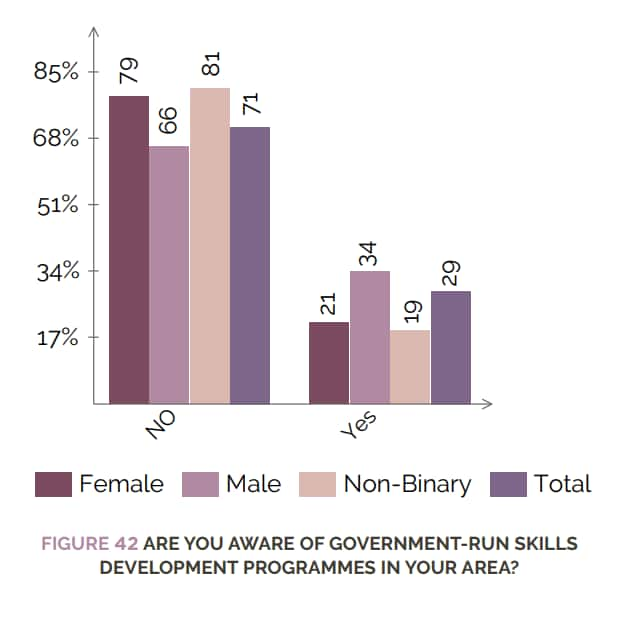



A major obstacle to the success of Prime Minister Narendra Modi's flagship Skill India programme is a lack of awareness about the government-run skill development program among youths.
Over 70 percent of the youths in the age group of 15 and 30 are unaware of government-run skill development programs, according to a 'Young India and Work' survey by the Observer Research Foundation and World Economic Forum (WEF).
As per the report, 81 percent of females and 74 percent of males said they have never been enrolled in a skill development programme, despite 76 percent of the 6,000 respondents stating a high interest in acquiring skills.
Modi had launched 'Skill India' campaign on July 15, 2015, with an aim to train over 40 crore people in India in different skills by 2022. The campaign includes various initiatives of the government such as National Skill Development Mission (NSDM), National Policy for Skill Development and Entrepreneurship, Pradhan Mantri Kaushal Vikas Yojana (PMKVY) and the Skill Loan scheme.
About 66 percent of male respondents and 79 percent of female respondents reported being unaware of government-run skills development programmes in their area.
 Source: Young India and work report.
Source: Young India and work report.
PM Modi's skill development scheme holds significance as about one-third of India’s working age population is between 15-64. The country's working age population will be more than the dependent population for at least three decades till 2040, according to a World Bank Report.
Read — DATA STORY: Young India set to replace China as Asia's superpower
The National Higher Education Commission estimated that an average age of the population in India by 2020 would be 29 years as against 40 years in USA, 46 years in Europe and 47 years in Japan. It is also estimated that during the next 20 years, the labour force in the industrial world is expected to decline by 4 percent, while in India it will increase by 32 percent.
In India, however, the skill development scheme has failed to pick up as about three-fourths of the youth in the country has never enrolled for a skill development program.
Despite a Budget allocation of Rs 3016.14 crores in FY18, the Ministry of Skill Development and Entrepreneurs spent only Rs 1488.44 crore in that fiscal year. While the Ministry conducted 133 training programmes across the country, the number of beneficiaries stood at only 5,426.
In FY17, over 9 million people across Ministries and Departments were enrolled under the government-run skill development programme, according to Ministry of Skill Development and Entrepreneurship annual report 2017-18.
 Source: Ministry of Skill Development and Entrepreneurship annual report.
Source: Ministry of Skill Development and Entrepreneurship annual report.
Interestingly, the Ministry of Skill Development and Entrepreneurship had projected the human resource requirement for FY17 at 510.8 million. So, the government fell short of nearly 501 million skilled labourers in 2017.
This highlights a paradoxical situation that the country is facing where on the one hand young men and women entering the labour market are looking for jobs; on the other hand industries are complaining of unavailability of appropriately skilled manpower.
As per India Labour Report 2012, it is estimated that 12.8 million new persons join the labour market annually vis-à-vis the current capacity of the skill development which is 3.1 million in our country.
 Source: Ministry of Skill Development and Entrepreneurship annual report.
Source: Ministry of Skill Development and Entrepreneurship annual report.
While the above data reflects the existing gap between the availability of skilled labourers and their demand, the study throws lights on the potential misalignment between the youth's aspiration and the government's plan. It also highlights a disconnect between the government-run skill development programmes and youth sentiments.
The low training participation in the government-run skill development programme was mainly on account of financial and time issues as over 80 percent of youth stated that they would prefer skills training programmes that provide some form of monetary compensation, such as a stipend.
 Source: Young India and work report.
Source: Young India and work report.
Over 4o percent of respondents said that they would prefer to participate in skills programmes that last up to four weeks while 35 percent stated that they would be keen to participate in programmes that last up to 6 months.
The respondents listed the following characteristics that make a skill development programme attractive -- moderate time commitment, monetary compensation, certification, and a mix of online and classroom content.
The list may help the government to shape skill development programmes and make it attractive and productive to motivate the youth to aspire for it.
While the lack of awareness is a major obstacle to the success of Skill India, there are other challenges for the government such as increasing the capacity to ensure equitable access for all, maintaining their quality and establishing strong linkages between the industry and the trainer institute for smooth hiring.
The fact that 93 percent of the total labour force is in the unorganised sector pose a different set of challenges to provide these labourers with skills, which would make them employable in an organised sector and improve their quality of life.
Other challenges include the creation of an institutional mechanism for research development, quality assurance, examination, certification, affiliation, and accreditation.
Discover the latest Business News, Sensex, and Nifty updates. Obtain Personal Finance insights, tax queries, and expert opinions on Moneycontrol or download the Moneycontrol App to stay updated!
Find the best of Al News in one place, specially curated for you every weekend.
Stay on top of the latest tech trends and biggest startup news.